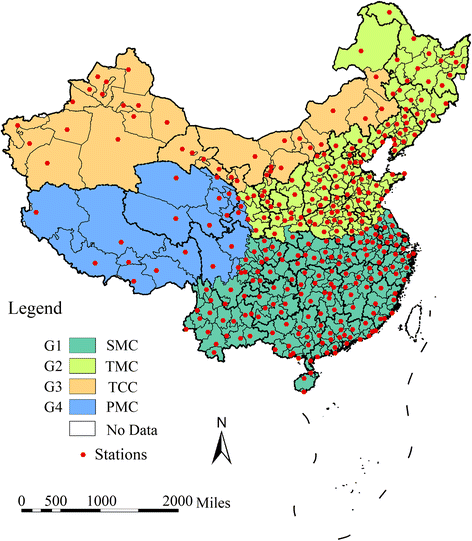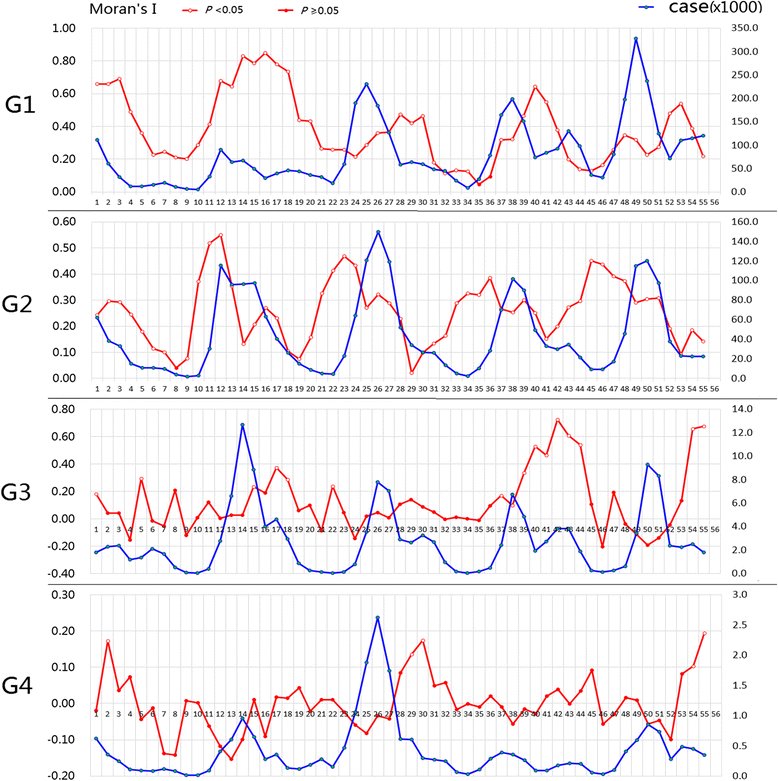Different effects of meteorological factors on hand, foot and mouth disease in various climates: a spatial panel data model analysis
- PMID: 27230283
- PMCID: PMC4881061
- DOI: 10.1186/s12879-016-1560-9
Different effects of meteorological factors on hand, foot and mouth disease in various climates: a spatial panel data model analysis
Abstract
Background: Major outbreaks of hand, foot and mouth disease (HFMD) have been reported in China since 2008, posing a great threat to the health of children. Although many studies have examined the effect of meteorological variables on the incidence of HFMD, the results have been inconsistent. This study aimed to quantify the relationship between meteorological factors and HFMD occurrence in different climates of mainland China using spatial panel data models.
Methods: All statistical analyses were carried out according to different climate types. We firstly conducted a descriptive analysis to summarize the epidemic characteristics of HFMD from May 2008 to November 2012 and then detected the spatial autocorrelation of HFMD using a global autocorrelation statistic (Moran's I) in each month. Finally, the association between HFMD incidence and meteorological factors was explored by spatial panel data models.
Results: The 353 regions were divided into 4 groups according to climate (G1: subtropical monsoon climate; G2: temperate monsoon climate; G3: temperate continental climate; G4: plateau mountain climate). The Moran's I values were significant with high correlations in most months of group G1 and G2 and some months of group G3 and G4. This suggested the existence of a high spatial autocorrelation with HFMD. Spatial panel data models were more appropriate to describe the data than fixed effect models. The results showed that HFMD incidences were significantly associated with average atmospheric pressure (AAP), average temperature (AT), average vapor pressure (AVP), average relative humidity (ARH), monthly precipitation (MP), average wind speed (AWS), monthly total sunshine hours (MSH), mean temperature difference (MTD), rain day (RD) and average temperature distance (ATD), but the effect of meteorological factors might differ in various climate types.
Conclusions: Spatial panel data models are useful and effective when longitudinal data are available and spatial autocorrelation exists. Our findings showed that meteorological factors were related to the occurrence of HFMD, which were also affected by climate type.
Keywords: Climate type; Hand, foot and mouth disease; Meteorological factors; Spatial panel data model.
Figures


Similar articles
-
Detecting the association between meteorological factors and hand, foot, and mouth disease using spatial panel data models.Int J Infect Dis. 2015 May;34:66-70. doi: 10.1016/j.ijid.2015.03.007. Epub 2015 Mar 11. Int J Infect Dis. 2015. PMID: 25770912
-
Spatio-temporal analysis of the relationship between climate and hand, foot, and mouth disease in Shandong province, China, 2008-2012.BMC Infect Dis. 2015 Mar 24;15:146. doi: 10.1186/s12879-015-0901-4. BMC Infect Dis. 2015. PMID: 25887074 Free PMC article.
-
Short-Term Effects of Climatic Variables on Hand, Foot, and Mouth Disease in Mainland China, 2008-2013: A Multilevel Spatial Poisson Regression Model Accounting for Overdispersion.PLoS One. 2016 Jan 25;11(1):e0147054. doi: 10.1371/journal.pone.0147054. eCollection 2016. PLoS One. 2016. PMID: 26808311 Free PMC article.
-
Association of Short-Term Exposure to Meteorological Factors and Risk of Hand, Foot, and Mouth Disease: A Systematic Review and Meta-Analysis.Int J Environ Res Public Health. 2020 Oct 30;17(21):8017. doi: 10.3390/ijerph17218017. Int J Environ Res Public Health. 2020. PMID: 33143315 Free PMC article.
-
Temperature and humidity affect the incidence of hand, foot, and mouth disease: a systematic review of the literature - a report from the International Society of Dermatology Climate Change Committee.Int J Dermatol. 2019 Apr;58(4):388-399. doi: 10.1111/ijd.14188. Epub 2018 Sep 5. Int J Dermatol. 2019. PMID: 30187452
Cited by
-
Health impact of climate change in cities of middle-income countries: the case of China.Br Med Bull. 2019 Jun 19;130(1):5-24. doi: 10.1093/bmb/ldz011. Br Med Bull. 2019. PMID: 31070715 Free PMC article. Review.
-
Spatiotemporally comparative analysis of three common infectious diseases in China during 2013-2015.BMC Infect Dis. 2022 Oct 18;22(1):791. doi: 10.1186/s12879-022-07779-4. BMC Infect Dis. 2022. PMID: 36258165 Free PMC article.
-
Geographical variations and influential factors in prevalence of cardiometabolic diseases in South Korea.PLoS One. 2018 Oct 2;13(10):e0205005. doi: 10.1371/journal.pone.0205005. eCollection 2018. PLoS One. 2018. PMID: 30278073 Free PMC article.
-
Meteorological factors and the incidence of mumps in Fujian Province, China, 2005-2013: Non-linear effects.Sci Total Environ. 2018 Apr 1;619-620:1286-1298. doi: 10.1016/j.scitotenv.2017.11.108. Epub 2017 Nov 22. Sci Total Environ. 2018. PMID: 29734606 Free PMC article.
-
Effect of climate factors on the incidence of hand, foot, and mouth disease in Malaysia: A generalized additive mixed model.Infect Dis Model. 2021 Aug 16;6:997-1008. doi: 10.1016/j.idm.2021.08.003. eCollection 2021. Infect Dis Model. 2021. PMID: 34466760 Free PMC article.
References
-
- World Health Organization . A guide to clinical management and public health response for Hand, Foot and Mouth disease (HFMD) Geneva: WHO Press; 2011.
-
- Chinese Center for Disease Control and Prevention (China CDC). National incidence and death cases of notifiable class A or class B infectious disease (2008, 2009, 2010, 2011, 2012). (http://www.chinacdc.cn). Accessed 03 Apr 2014.
MeSH terms
LinkOut - more resources
Full Text Sources
Other Literature Sources
Research Materials
Miscellaneous

